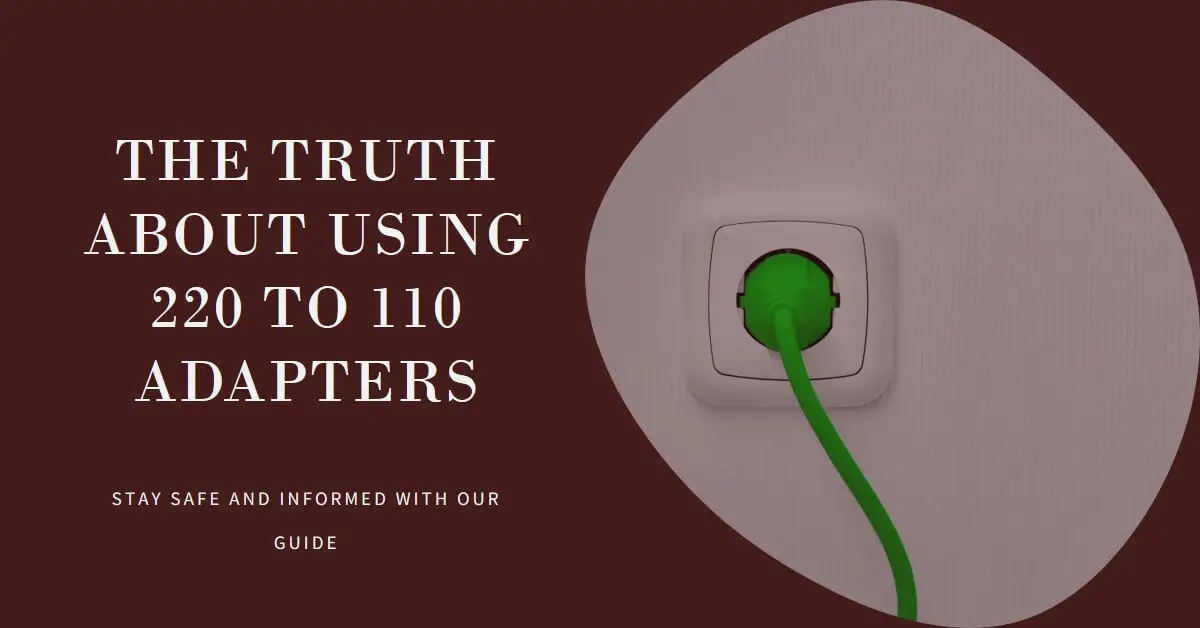Image: “Article Feature Image” by Bing, Source: [Bing Graphic Art].
In our increasingly globalized world, where electrical systems vary from country to country, it’s not uncommon to encounter situations where you need to use electrical devices designed for a different voltage.
One solution often considered is using a 220 to 110 adapter. However, it’s essential to understand the safety implications before proceeding.
Using a high-quality, certified voltage adapter can be a safe solution for converting the voltage from 220V to 110V, allowing you to use your devices without risking equipment damage, fire hazards, or electrical shocks.
This article aims to provide an overview of the topic and guide you in making an informed decision.
Understanding Voltage Differences
Explanation of 220V and 110V Systems
In the United States, the standard voltage for residential electrical systems is 110 volts (V), while many other countries, including parts of Europe and Asia, use 220V.
This disparity arises due to historical differences in electrical infrastructure and regulations. It’s important to note that plugging a 220V device into a 110V outlet can damage the device, while plugging a 110V device into a 220V outlet may result in reduced performance or complete malfunction.
Regional Variations in Voltage Standards
The variation in voltage standards worldwide necessitates the use of voltage adapters or converters when traveling or relocating to a different country.
These devices help match the voltage requirements of your appliances to the local electrical system. However, it’s crucial to understand the safety considerations associated with using a 220 to 110 adapter specifically.
Is it safe to use a 220v to 110v adapter?
It is generally safe to use a high-quality, certified voltage adapter from 220V to 110V when the following conditions are met:
- Compatibility: Ensure that your devices are compatible with the voltage conversion. Some modern electronic devices, such as laptops or smartphones, are designed to handle a wide range of voltages and may not require an adapter. However, appliances with motors or heating elements, like refrigerators or hair dryers, typically require more careful consideration.
- High-Quality and Certification: Select a reputable, high-quality adapter that is specifically designed for converting 220V to 110V. Look for certifications or approvals from recognized standards organizations, as this indicates that the adapter meets safety and performance requirements.
- Load Capacity: Verify that the adapter’s load capacity is sufficient to handle the power requirements of your devices. Overloading the adapter can lead to overheating, equipment damage, and safety risks. Check the wattage or amperage ratings of both the adapter and your devices to ensure compatibility.
- Proper Installation: Follow the manufacturer’s instructions carefully when installing the adapter. Ensure that the wiring and connections are secure, avoiding loose or exposed wires. Regularly inspect the adapter and associated components for any signs of damage or wear.
- Professional Guidance: When in doubt or if you have concerns about electrical safety, consult a professional electrician. They can assess your specific electrical setup, provide expert advice, and ensure that the adapter is installed and used correctly.
By adhering to these guidelines, using a high-quality, certified voltage adapter can be a safe solution for converting the voltage from 220V to 110V, allowing you to use your devices without risking equipment damage, fire hazards, or electrical shocks.
Potential Risks of Using Low-quality Adapter
Overloading Electrical Circuits
One significant risk of using a 220 to 110 adapter is overloading the electrical circuits. While the adapter may allow you to connect your 110V device to a 220V outlet, the circuitry, and wiring within your home or building may not be designed to handle the increased electrical load. This can lead to circuit breakers tripping or, in the worst cases, electrical fires.
Equipment Damage and Fire Hazards
Using a 220 to 110 adapter can potentially damage your electrical devices. Devices designed for 110V may not be equipped to handle the higher voltage provided by the adapter, leading to overheating, component failure, or even fire hazards.
It’s important to consider the potential consequences and the value of your devices before opting for this solution.
Electrical Shock and Personal Safety
Another critical concern is personal safety. Mishandling or improper use of adapters can lead to electrical shocks, which can cause severe injury or even be fatal.
The voltage conversion process requires careful attention to wiring and connections to ensure a safe electrical environment.
Factors to Consider
Compatibility of Devices
Before considering the use of a 220 to 110 adapter, it’s essential to check the compatibility of your devices.
Some modern electronic devices, such as laptops or smartphones, are designed to work with a wide range of voltages, which may eliminate the need for an adapter.
However, appliances with motors or heating elements, such as refrigerators or hair dryers, typically require more careful consideration.
Quality and Certification of Adapters
When using voltage adapters, it’s crucial to choose high-quality, certified products from reputable manufacturers.
Cheap or uncertified adapters may pose a higher risk of electrical hazards, and their performance may be unreliable.
Consulting professional electricians or seeking guidance from trusted sources can help in selecting the right adapter for your needs.
Power Consumption and Load Capacity
Adapters have specific load capacities, which indicate the maximum power they can safely handle. It’s vital to assess the power requirements of your devices and ensure that the adapter’s load capacity is sufficient. Overloading the adapter can lead to overheating, equipment damage, and safety risks.
Safe Usage Guidelines
Consulting a Professional Electrician
To ensure electrical safety, it’s highly recommended to consult a professional electrician when considering the use of a 220v to 110v adapter.
They can assess the suitability of your electrical system, guide you on proper wiring and installation, and provide valuable advice on alternative solutions if necessary.
Proper Wiring and Connections
If you decide to use a 220 to 110 adapter, it’s essential to follow the manufacturer’s instructions meticulously.
Ensure that the wiring and connections are secure, avoiding loose connections or exposed wires. Regularly inspect the adapter and associated components for any signs of damage or wear.
Regular Inspections and Maintenance
Maintaining a safe electrical environment involves periodic inspections and maintenance. Check the condition of your adapter, wiring, and outlets to identify any potential issues.
Over time, components can deteriorate, so prompt repairs or replacements are essential to prevent electrical hazards.
Alternatives to Using a 220 to 110 Adapter
Purchasing Dual Voltage Devices
If you frequently travel or plan to relocate, investing in dual-voltage devices can be a convenient and safer alternative.
Dual voltage devices are designed to work seamlessly with both 110V and 220V systems, eliminating the need for adapters or converters.
Using Voltage Converters or Transformers
In situations where you have devices that are not compatible with different voltages, voltage converters or transformers can provide a reliable solution.
These devices convert the incoming voltage to match the requirements of your appliances. However, it’s important to choose the right converter or transformer that can handle the necessary power load and ensure safety.
Conclusion
While using a 220 to 110 adapter may seem like a quick solution for voltage mismatches, it comes with potential risks and safety concerns.
Understanding the implications, consulting professionals, and considering alternative solutions are crucial steps in ensuring electrical safety.
Prioritizing the well-being of yourself, your devices, and your property is essential when navigating the complexities of electrical systems around the world.


